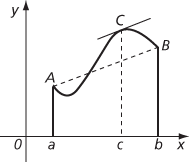Let f and g be two real functions on the interval [a,b] and assume that g(x) > 0 for all x.
If m ≤ f(x) ≤ M for all x, then
If f is a continuous function on [a,b], then there exists c in (a,b) such that
Let f be a function that is continuous on [a, b] and differentiable in (a, b). The mean value theorem then states that there is a number c with a < c < b such that
This can be equivalently expressed as:there is a point C on the graph of f where the tangent is parallel to the line segment joining A(a,f(a)) to B(b,f(b)). If A, with coordinates (a, f(a)), and B, with coordinates (b, f(b)), are the points on the graph corresponding to the end‐points of the interval, there must be a point C on the graph between A and B at which the tangent is parallel to the chord AB.

Mean gradient achieved at C
Rolle’s Theorem is a special case of the mean value theorem. Taylor’s Theorem is an extension of the mean value theorem. The mean value theorem has two immediate corollaries:
(i) if f′(x) = 0 for all x, then f is a constant function,
(ii) if f′(x) > 0 for all x, then f is strictly increasing.
- Hall, Edwin Herbert
- Hall effect
- scintillation counter
- Scintillation Observations and Response of the Ionosphere to Electrodynamics
- Scintillation Prediction Observations Research Task
- scintillometer
- scintillometer survey
- scion
- Scipio Aemilianus (185–129)
- Scipio Africanus (236–184)
- Scirocco
- scirocco
- SCISAT
- SciSat-1/ACE
- scissoring
- sclera
- Scleractinia
- sclereid
- sclerenchyma
- sclerometer
- sclerophyllous
- scleroprotein
- sclerotic
- sclerotinite
- sclerotium